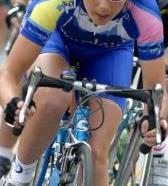Adjusting Saddle Height and Knees Out Pedaling
Posted by Matt Russ on 21st Feb 2020
 One of the easiest way to determine whether or not a cyclist is in need of a proper fitting is by observing their knees. When the saddle fore/aft is aligned properly, the height is set correctly, and the five variables of foot/pedal interface are adjusted accurately, the cyclists knees should be working under the hip, and the foot under the knee. During the fit process we use a laser line positioned from the front to measure and adjust alignment. When a saddle is too low the knees cannot stay under the hip and biomechanics force them naturally to the outside. You end up with a cyclists pedaling in a knees out position like a "v" which you have no doubt observed. It is important to note that a cyclists will generally "feel" when a saddle is too high. They will feel their hips rocking in the saddle as they reach unnaturally for the bottom of the pedal stroke; and they know instinctually that it is not right because it does not feel right. Conversely, when a saddle is too low a cyclist may even feel fairly comfortable; even though their power is severely diminished. I have performed fit evaluations in which the saddle was several inches too low, yet the cyclists did not realize how off their position was. Once their saddle height was properly set there was a significant increase in power as the leg now can capitalize on greater leverage and range of motion. A cleat position (or stance width) that is too narrow will also contribute to knees out of "v" shaped pedaling, but to a lesser extent.
One of the easiest way to determine whether or not a cyclist is in need of a proper fitting is by observing their knees. When the saddle fore/aft is aligned properly, the height is set correctly, and the five variables of foot/pedal interface are adjusted accurately, the cyclists knees should be working under the hip, and the foot under the knee. During the fit process we use a laser line positioned from the front to measure and adjust alignment. When a saddle is too low the knees cannot stay under the hip and biomechanics force them naturally to the outside. You end up with a cyclists pedaling in a knees out position like a "v" which you have no doubt observed. It is important to note that a cyclists will generally "feel" when a saddle is too high. They will feel their hips rocking in the saddle as they reach unnaturally for the bottom of the pedal stroke; and they know instinctually that it is not right because it does not feel right. Conversely, when a saddle is too low a cyclist may even feel fairly comfortable; even though their power is severely diminished. I have performed fit evaluations in which the saddle was several inches too low, yet the cyclists did not realize how off their position was. Once their saddle height was properly set there was a significant increase in power as the leg now can capitalize on greater leverage and range of motion. A cleat position (or stance width) that is too narrow will also contribute to knees out of "v" shaped pedaling, but to a lesser extent.
The legs should optimally be working horizontally like a couple of pistons with little medial/lateral deviation of the knee (although some slight knee in towards the top tube is not necessarily bad). If you find your knees are flaring outwards when you ride, or if you observe a fellow rider pedaling knees out, it is time for some adjustment or better yet a proper fitting. Note that simply raising the saddle also affects your fore/aft position and relation to the pedal spindle. This may cause anterior or posterior knee problems. As the saddle rises it also moves rearward due to the seat tube angle. A very rudimentary way to check saddle height is by placing your heel on the pedal- at bottom dead center the leg should almost be straight, but again this may only get you in the ball park and does not factor in fore/aft adjustment which is equally important.
Knees out pedaling is not good for the knee as it can adversely affect cartilage, ligaments, and tendons. The knee cap or patella has a groove it tracks in and by pedaling in such a way that promotes mis-alignment you may develop an overuse injury or patellofemoral syndrome. This may fray or wear out the cartilage under the knee cap. Proper knee alignment promotes use of the Vastus Medialis or the big teardrop shaped muscle closest to your top tube. The VMO is the main muscle holding your knee medially; and keeping that patella in line.
Observing or having someone observe your knee position while pedaling is the first stop in getting your fit right. It is an easy way to determine if it is off and usually that your saddle is too low. Correcting this will not only increase your power, it will put your knees in a much healthier position.


